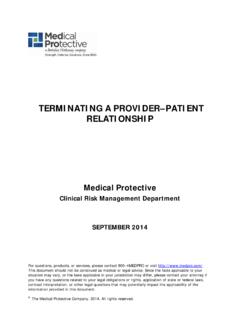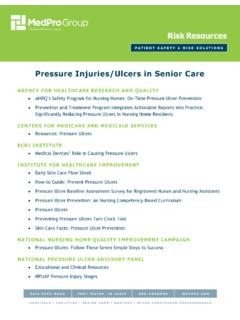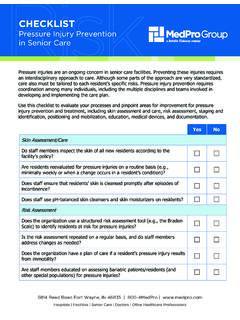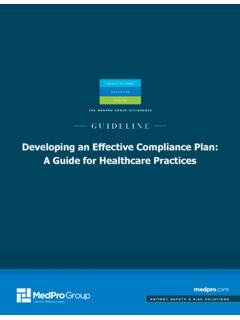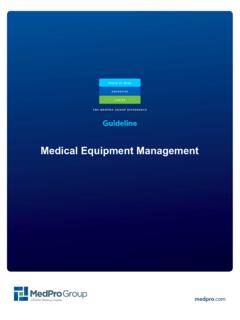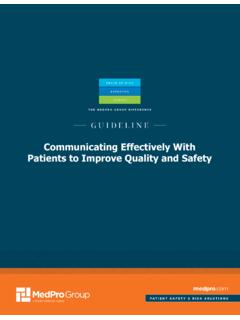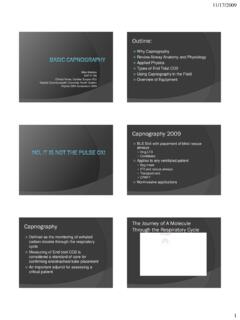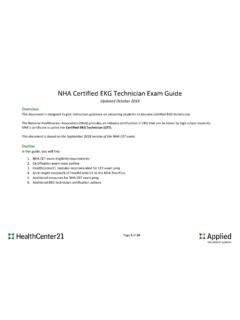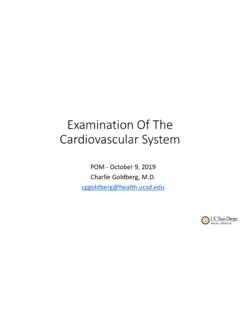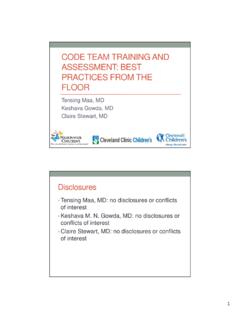Transcription of S I M U L A T I O N T R A I N I N G - MedPro
1 S A M P L E S C E N A R I O SSIMULATIONTRAININGP A T I E N T S A F E T Y&R I S K S O L U T I O N S 2017 MedPro Group Inc. All rights reserved. This document should not be construed as medical or legal advice. Because the facts applicable to your situation may vary, or the laws applicable in your jurisdiction may differ, please contact your attorney or other professional advisors if you have any questions related to your legal or medical obligations or rights, state or federal laws, contract interpretation, or other legal Group is the marketing name used to refer to the insurance operations of The Medical Protective Company, Princeton Insurance Company, PLICO, Inc. and MedPro RRG Risk Retention Group. All insurance products are underwritten and administered by these and other Berkshire Hathaway affiliates, including National Fire & Marine Insurance Company. Product availability is based upon business and regulatory approval and may differ between companies.
2 CONTENTS ANESTHESIA: SURGICAL TEAM SCENARIO .. 1 Scenario Background .. 1 Information for the Facilitator .. 1 Learning Objectives .. 1 Target Participants .. 2 Expected Outcomes .. 2 Facilitator Notes .. 2 Equipment and Supplies .. 3 Scenario Setup .. 4 Patient .. 4 Room .. 4 Scenario Commencement .. 4 Handoff Report for Participants .. 4 Scenario Steps .. 5 Patient Response and Participant Actions .. 5 Debrief .. 6 Resources .. 6 BEHAVIORAL HEALTH: DE-ESCALATION SCENARIO .. 9 Scenario Background .. 9 Information for the Facilitator .. 9 Learning Objectives .. 9 Target Participants .. 10 Expected Outcomes .. 10 Facilitator Notes .. 10 Equipment and Supplies .. 10 Scenario Setup .. 10 Patient .. 10 Room .. 10 Scenario Commencement .. 10 Handoff Report for Participants .. 10 Scenario Steps .. 11 Patient Response and Participant Actions .. 11 Debrief .. 12 Resources .. 12 EMERGENCY MEDICINE: PEDIATRIC PATIENT SCENARIO .. 15 Scenario Background.
3 15 Information for the Facilitator .. 15 Learning Objectives .. 15 Target Participants .. 16 Expected Outcomes .. 16 Facilitator Notes .. 16 Equipment and Supplies .. 17 Scenario Setup .. 17 Patient .. 17 Room .. 17 Scenario Commencement .. 17 Handoff Report for Participants .. 17 Scenario Steps .. 18 Patient Response and Participant Actions .. 18 Debrief .. 19 Resources .. 19 HEALTHCARE PRACTICE: EMERGENCY SCENARIO .. 21 Scenario Background .. 21 Information for the Facilitator .. 21 Learning Objectives .. 21 Target Participants .. 21 Expected Outcomes .. 22 Facilitator Notes .. 22 Equipment and Supplies .. 23 Scenario Setup .. 23 Patient .. 23 Room .. 23 Scenario Commencement .. 23 Handoff Report for Participants .. 23 Scenario Steps .. 24 Patient Response and Participant Actions .. 24 Debrief .. 25 Resources .. 25 MEDICAL-SURGICAL NURSING: SEPSIS SCENARIO .. 27 Scenario Background .. 27 Information for the Facilitator .. 27 Learning Objectives.
4 27 Target Participants .. 28 Expected Outcomes .. 28 Facilitator Notes .. 28 Equipment and Supplies .. 28 Scenario Setup .. 29 Patient .. 29 Room .. 29 Scenario Commencement .. 29 Handoff Report for Participants .. 29 Scenario Steps .. 30 Patient Response and Participant Actions .. 30 Debrief .. 32 Resources .. 32 SENIOR CARE: FALL ASSESSMENT SCENARIO .. 35 Scenario Background .. 35 Information for the Facilitator .. 35 Learning Objectives .. 35 Target Participants .. 35 Expected Outcomes .. 36 Facilitator Notes .. 36 Equipment and Supplies .. 36 Scenario Setup .. 37 Resident .. 37 Room .. 37 Scenario Commencement .. 37 Handoff Report to Participants .. 37 Scenario Steps .. 38 Resident Response and Participant 38 Debrief .. 39 Resources .. 39 OBSTETRICS: SHOULDER DYSTOCIA SCENARIO .. 41 Scenario Background .. 41 Information for the Facilitator .. 41 Learning Objectives .. 41 Target Participants .. 41 Expected Outcomes .. 42 Facilitator Notes.
5 42 Equipment and Supplies .. 43 Scenario Setup .. 44 Patient .. 44 Room .. 44 Scenario Commencement .. 45 Handoff Report to Participants .. 45 Scenario Steps .. 45 Patient Response and Participant Actions .. 45 Debrief .. 46 Resources .. 47 DENTAL PRACTICE: AGGRESSIVE PATIENT SCENARIO .. 49 Scenario Background .. 49 Information for the Facilitator .. 49 Learning Objectives .. 49 Target Participants .. 49 Expected Outcomes .. 50 Facilitator Notes .. 50 Equipment and Supplies .. 50 Scenario Setup .. 50 Patient .. 50 Room .. 51 Scenario Commencement .. 51 Handoff Report for Participants .. 51 Scenario Steps .. 51 Patient Response and Participant Actions .. 51 Debrief .. 52 Resources .. 52 S U R G I C A L T E A M S C E N A R I OANESTHESIAS imulation Scenarios 1 ANESTHESIA: SURGICAL TEAM SCENARIOThe purpose of this scenario is to practice effective communication and efficient teamwork skills, such as those defined in crew resource management programs and the Agency for Healthcare Research and Quality s (AHRQ s) TeamSTEPPS program.
6 For more details, refer to the Facilitator Notes on page 2. This scenario is designed for an OR setting; however, the setting can be adjusted based on individual facility practices. Scenario Background Information for the Facilitator The patient is being admitted to the hospital because of end-stage renal failure. Her past medical history is significant for diabetes, hypertension, severe anemia, and suspected sepsis. On admission, the patient s BP is 150 160/100. During the admission, the patient receives dialysis on five occasions. It is then determined that the access catheter needs to be changed. An anesthesiologist evaluates the patient and determines that she is ASA-IV. The patient is dialyzed prior to the procedure. At 1430, the anesthesiologist administers IV sedation with midazolam 1 mg. Pulse oximetry and ECG monitoring are in place. BP is 120/60 at 1430, 110/60 at 1435, and 100/60 at 1445. Normal saline is administered at 100 mL/hr.
7 At 1450, the patient s BP drops to 80/60. The anesthesiologist administers atropine mg. The surgeon replaces the catheter in 10 minutes. At the end of the procedure, the patient becomes bradycardic (30 40 beats per minute) and then asystolic. The circulating nurse administers epinephrine 1 mg IV, the anesthesia provider intubates the patient, and a code is called at 1456 (simultaneously). Learning Objectives During this scenario, participants will: Recognize risks for complications and plan for appropriate monitoring Provide appropriate and timely interventions (response to changes in physiologicalstatus) Exhibit proficient technical performance of interventions (code response)Simulation Scenarios 2 Demonstrate effective communication with team members Integrate resourceful teamwork in providing patient care Target Participants OR staff, surgeon(s), and anesthesia providers/staff Expected Outcomes Short-term: Implement effective communication and efficient teamwork concepts.
8 TeamSTEPPS-specific tools should include: brief, huddle, situation awareness, cross-monitoring, CUS, and the two-challenge rule. Long-term: Demonstrate improved patient outcomes for similar patient types. Facilitator Notes Below are tips to help the facilitator conduct the simulation. Throughout this scenario, participants will be tasked with identifying opportunities to apply effective communication and efficient teamwork skills, such as the ones recommended by TeamSTEPPS. The tools and strategies specific to this scenario include: brief, huddle, situation awareness, cross-monitoring, CUS, and the two-challenge rule. Visit AHRQ s website for more information about TeamSTEPPS. Give each participant his/her own patient chart to review. This enables him/her to obtain basic information about the patient. However, prevent discussion among members of the patient care team prior to the administration of midazolam. This puts the team members in a situation in which no focus is on potential complications for this highly compromised patient.
9 Again, the goal is to have patient care team members proactively initiate a discussion (brief) prior to the procedure so that everyone is aware of what to look for (situation awareness) and ready to assist each other in performing their tasks as needed (cross-monitoring). Once a complication is recognized and shared with the team, and treatment efforts are initiated, attention to the patient s treatment response is paramount (situation awareness). When information regarding complications isn t shared and interventions aren t effective to the level desired, a team discussion about additional options (huddle) should take place. Continuing with the initial procedure should elicit a response from team members , questioning or stating concern about the patient s safety (CUS and/or two-challenge rule). NOTE If you prefer not to use the TeamSTEPPS tools, a description of what is expected from the participants is provided. Simply disregard the words in parentheses in the paragraphs below.
10 Simulation Scenarios 3 It is recommended that participants perform this scenario twice in the same training session so that learning and re-enforcement of communication and teamwork skills can be applied to their clinical practice. Throughout the scenario, the facilitator will need to provide data for the patient s vital signs (see Scenario Steps on page 5). The data should be displayed on a card, paper, or placard located near the actual monitor. Additionally, to facilitate the time needed for each scenario session, the facilitator has the option to compress (speed up) time as needed. Make the participants aware of the time by either displaying the time in a visible location or stating the time throughout the scenario. Equipment and Supplies Operating room bed and bed sheet Cardiac monitor/anesthesia machine and pulse oximetry with displays demonstratingpatient s hemodynamic baseline and subsequent decompensation Endotracheal tube (ETT) with lubricant ETT holder Hemodialysis catheters (old one to be removed/new one to be inserted) IV cannula, fluid, and tubing Paper tape (to secure IV, dialysis catheter, and IV cannula) Scrub gowns, scrub caps, and shoe covers Surgical procedure supplies (sterile field, drapes, etc.)
